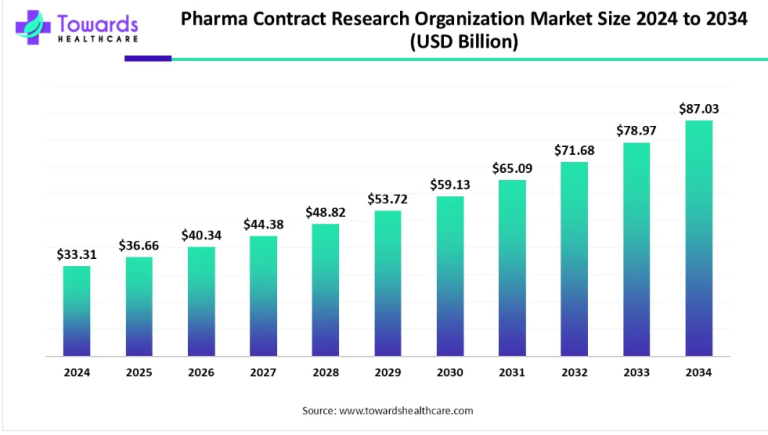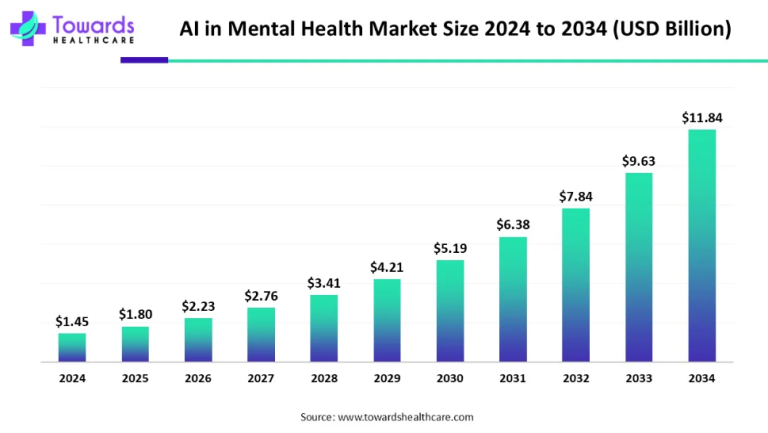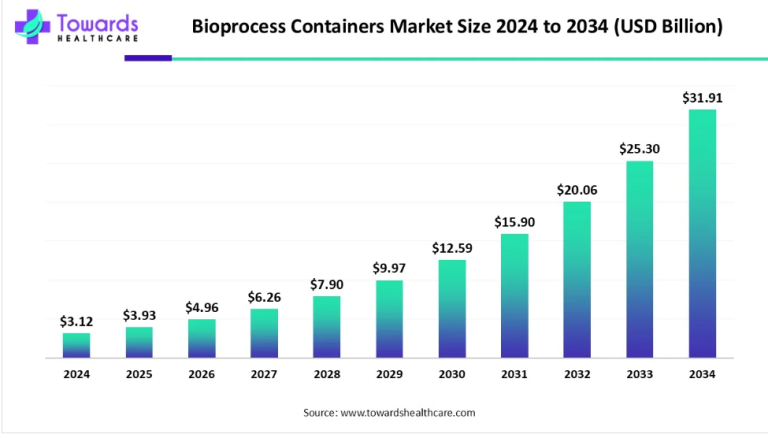In the dynamic realm of healthcare technology, the global anesthesia monitoring devices market is poised for remarkable growth. With an estimated market value of USD 2.41 billion in 2022, this sector is set to experience a compelling 9.5% Compound Annual Growth Rate (CAGR) from 2023 to 2032. By the culmination of this transformative decade, projections indicate a soaring market value of approximately USD 5.96 billion. Let’s delve into the factors propelling this surge and how the landscape is evolving with a preference shift towards non-invasive treatment options.
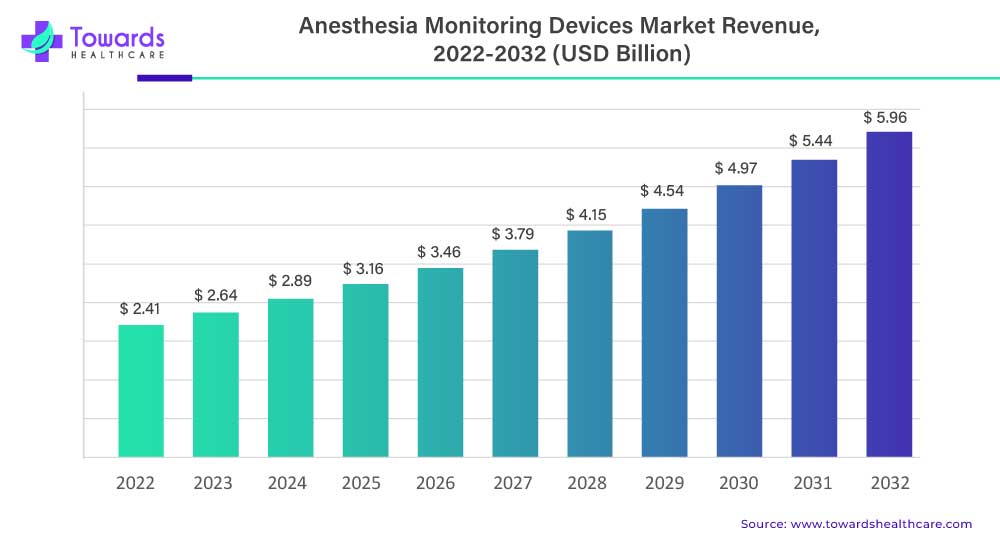
The anesthesia monitoring devices market refers to the global market for devices used to monitor patients’ vital signs and anesthesia levels during surgical procedures. These devices play a crucial role in ensuring patient safety and optimizing anesthesia management. The market for anesthesia monitoring devices has been growing steadily due to factors such as the increasing number of surgeries, advancements in technology, and the rising focus on patient safety. Anesthesia monitoring devices are used in various surgical specialties, including cardiology, orthopedics, neurology, and general surgery.
The market is driven by the growing demand for efficient and accurate monitoring solutions, as well as the increasing adoption of minimally invasive surgical techniques. Anesthesia monitoring devices help anesthesiologists and healthcare professionals closely monitor vital signs, such as heart rate, blood pressure, oxygen saturation, and end-tidal carbon dioxide levels, ensuring the patient’s well-being during surgery.
The Role of Advanced Anesthesia Monitors
Advanced anesthesia monitors have indeed played a significant role in driving the growth of the anesthesia monitoring devices market. These monitors incorporate advanced technologies and features that enhance the accuracy, efficiency, and safety of anesthesia administration. They provide real-time monitoring of vital signs and anesthesia parameters, allowing healthcare professionals to make informed decisions during surgeries.
The dominance of advanced anesthesia monitors in the market can be attributed to several driving factors. First and foremost, these monitors offer a higher level of precision and accuracy in monitoring patients’ vital signs, such as blood pressure, heart rate, oxygen saturation, and end-tidal carbon dioxide levels. This accuracy is crucial for ensuring patient safety and optimizing anesthesia management.
In addition, the integration of advanced features and capabilities in anesthesia monitors has revolutionized the monitoring process. Features such as waveform analysis allow for detailed assessment of vital signs, while automated alarms provide immediate alerts in case of critical changes. The seamless integration of data with electronic medical records enables comprehensive patient monitoring and facilitates efficient data analysis for accurate diagnosis and treatment decisions. These advancements contribute to improved patient care by enhancing the accuracy, efficiency, and effectiveness of anesthesia monitoring procedures.
The growing acceptance of minimally invasive surgical approaches has significantly contributed to the demand for advanced anesthesia monitors. These procedures necessitate meticulous monitoring of the patient’s physiological parameters throughout the surgery. Advanced anesthesia monitors play a crucial role in providing real-time data on vital signs, such as heart rate, blood pressure, oxygen saturation, and end-tidal carbon dioxide levels, allowing anesthesiologists to adjust anesthesia levels accurately and promptly. By enabling precise monitoring during minimally invasive surgeries, these advanced monitors enhance patient safety, optimize anesthesia management, and improve surgical outcomes.
Moreover, the growing emphasis on patient safety and the need for continuous monitoring throughout the surgical process has fueled the demand for advanced anesthesia monitors. These monitors allow healthcare professionals to closely monitor patients, detect any changes or complications promptly, and take appropriate actions in real time, thereby enhancing patient outcomes.
In addition to these factors, advancements in technology, such as the integration of artificial intelligence (AI) and machine learning algorithms, are further driving the development of advanced anesthesia monitors. AI-powered monitors can analyze patient data, identify patterns, and provide predictive insights, assisting healthcare professionals in making informed decisions and improving anesthesia delivery.
Thus, the dominance of advanced anesthesia monitors in the market is a result of their superior capabilities, enhanced accuracy, and the growing focus on patient safety. These monitors will continue to drive the growth of the anesthesia monitoring devices market as healthcare providers strive for more precise and efficient anesthesia management during surgical procedures.
The Role of Hospitals in the Anesthesia Monitoring Devices Market
Hospitals have indeed played a significant role in dominating the anesthesia monitoring devices market. The demand for anesthesia monitoring devices is primarily driven by the usage and adoption of these devices in hospitals, where a large number of surgical procedures take place.
In addition, hospitals have the necessary infrastructure and resources to invest in advanced medical equipment, such as anesthesia monitoring devices. These devices are considered essential for ensuring patient safety and optimizing anesthesia management during surgical procedures. Hospitals prioritize providing high-quality care to their patients and allocate budgets and resources to acquire and maintain state-of-the-art medical equipment, including anesthesia monitors. By investing in advanced technology, hospitals can enhance the efficiency and effectiveness of anesthesia monitoring, leading to improved patient outcomes and overall quality of care.
Furthermore, hospitals have a dedicated anesthesia department or anesthesia team responsible for managing anesthesia during surgeries. These professionals rely on anesthesia monitoring devices to assess and manage patients’ vital signs, administer appropriate anesthesia levels, and ensure patient safety throughout the surgical process. Hospitals prioritize the availability of reliable and accurate monitoring devices to support their anesthesia teams in delivering optimal care.
Moreover, hospitals often handle a wide range of surgical specialties, such as cardiology, orthopedics, general surgery, and neurosurgery, among others. Each specialty may have specific requirements for anesthesia monitoring, which further drives the demand for a variety of anesthesia monitoring devices. Hospitals cater to these diverse needs and invest in a range of devices to support different surgical specialties. Hospitals serve as centers for medical research, education, and training.
Hospitals dominate the anesthesia monitoring devices market due to the high volume of surgical procedures, their commitment to patient safety, the availability of resources for investment, and their role as centers for medical research and education. The demand from hospitals is a significant driving factor for the growth and advancement of anesthesia monitoring devices in the market.
The Role of Increasing Number of Surgical Procedures
The increasing number of surgical procedures is a significant driving factor behind the growth of the anesthesia monitoring devices market. Advancements in surgical techniques and procedures have expanded the scope of surgeries performed. Minimally invasive procedures, robotic surgeries, and complex surgeries that were once considered high-risk are now more accessible. With the growing range of surgical procedures, the demand for anesthesia monitoring devices to ensure patient safety during anesthesia administration has also increased.
Patient safety is a top priority in healthcare, and anesthesia monitoring devices play a crucial role in ensuring safe anesthesia administration. These devices monitor patients’ vital signs, such as heart rate, blood pressure, oxygen saturation, and end-tidal carbon dioxide levels, in real-time. The emphasis on patient safety drives healthcare providers to invest in advanced anesthesia monitoring devices, leading to market growth.
Chronic diseases, such as diabetes, obesity, and cardiovascular diseases, are on the rise globally. As of 2022, it is estimated that nearly 2.3 billion individuals, including both children and adults, were living with overweight and obesity globally. This significant number highlights the growing prevalence of this health concern, which can have various implications for individuals and public health systems worldwide. These conditions often require surgical interventions for diagnosis, treatment, or management. As the prevalence of chronic diseases increases, the demand for surgical procedures also grows, thereby driving the market for anesthesia monitoring devices.
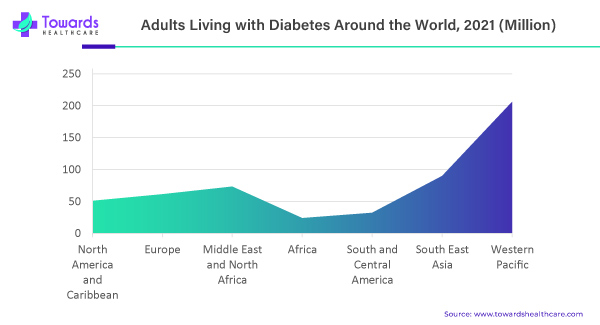
Riding the Growth Wave: Anesthesia Monitoring Devices Market Overview
The Current Landscape (2022)
As of 2022, the global anesthesia monitoring devices market stands at an impressive USD 2.41 billion. This figure encapsulates the widespread adoption of advanced monitoring technologies within the healthcare sector, reflecting a commitment to ensuring patient safety and optimizing anesthesia delivery.
Projecting Forward: Anticipated Growth (2023-2032)
Fast forward to the upcoming decade, and we witness a striking trajectory with a projected 9.5% CAGR. The forecasted market value of USD 5.96 billion by 2032 mirrors an escalating demand for anesthesia monitoring devices. This surge can be attributed to several pivotal factors shaping the healthcare landscape.
Unraveling the Forces Behind the Growth
1. Technological Advancements Driving Adoption
In an era dominated by technological innovation, anesthesia monitoring devices are not immune to the wave of advancements. The integration of cutting-edge technologies enhances monitoring accuracy and provides healthcare professionals with real-time insights, revolutionizing patient care.
2. Surge in Demand for Non-Invasive Treatment
One of the prominent catalysts steering the growth of the anesthesia monitoring devices market is the escalating preference for non-invasive treatment options. Patients and healthcare practitioners alike are increasingly gravitating towards methods that minimize invasiveness while ensuring optimal therapeutic outcomes.
3. Evolving Regulatory Landscape
As the healthcare industry navigates a complex regulatory terrain, the emphasis on compliance and adherence to standards becomes paramount. Anesthesia monitoring devices that meet stringent regulatory requirements are gaining traction, fostering trust among stakeholders and propelling market growth.
Navigating the Path Ahead: Opportunities and Challenges
1. Opportunities on the Horizon
The burgeoning market presents a myriad of opportunities for industry players. Collaborations for research and development, strategic partnerships, and a focus on innovation are avenues that can unlock new frontiers and contribute to sustained market expansion.
2. Addressing Challenges Head-On
Despite the promising trajectory, challenges such as stringent regulatory scrutiny and the need for substantial investments in research and development persist. Industry stakeholders must navigate these challenges adeptly to ensure the continued upward trajectory of the anesthesia monitoring devices market.
Technological advancements in anesthesia monitoring devices have improved their accuracy, efficiency, and user-friendliness. Advanced monitoring systems offer features such as real-time data monitoring, integration with electronic health records, and advanced alarm systems. These advancements enhance patient safety and optimize anesthesia administration, making them increasingly valuable in surgical settings.
The aging population is driving the need for surgical interventions. Older adults often require surgical procedures for various health conditions, such as cardiovascular diseases, joint replacements, and cancer treatment. The rise in the aging population contributes to the overall increase in surgical procedures and subsequently fuels the demand for anesthesia monitoring devices.
Thus, the increasing number of surgical procedures is driven by surgical advancements, the aging population, the prevalence of chronic diseases, technological advancements in monitoring devices, emphasis on patient safety, regulatory guidelines, and expanding healthcare infrastructure. These factors collectively contribute to the growth of the anesthesia monitoring devices market.
The Rising Demand for Non-Invasive Monitoring Augments the Market Growth
The rising demand for non-invasive monitoring is a significant driving factor behind the growth of the anesthesia monitoring devices market. Non-invasive monitoring refers to the collection of vital signs and other physiological data without the need for invasive procedures or devices that penetrate the patient’s body. Non-invasive monitoring methods provide a safer and more comfortable experience for patients undergoing anesthesia. Traditional invasive monitoring techniques may involve the insertion of catheters, needles, or probes, which can be uncomfortable and carry a risk of complications. Non-invasive monitoring techniques, such as pulse oximetry, non-invasive blood pressure monitoring, and capnography, offer accurate measurements without invasive procedures, enhancing patient safety and comfort.
Invasive monitoring procedures carry a risk of introducing infections. By utilizing non-invasive monitoring methods, healthcare providers can minimize the risk of infections associated with invasive devices, such as catheter-related bloodstream infections. This is particularly important in surgical settings where maintaining a sterile environment is crucial. Non-invasive monitoring devices are generally user-friendly and accessible to healthcare professionals across different settings.
They are often portable, compact, and easy to operate, allowing for seamless integration into various healthcare environments, including operating rooms, intensive care units, and outpatient settings. The ease of use and accessibility of non-invasive monitoring devices contribute to their increasing adoption. The shift towards outpatient surgical procedures and ambulatory care has increased the demand for non-invasive monitoring devices. As more surgeries and procedures are performed on an outpatient basis, non-invasive monitoring becomes crucial for ensuring patient safety and successful outcomes in these settings.
The rising demand for non-invasive monitoring in anesthesia is driven by factors such as patient safety and comfort, minimizing infection risks, continual monitoring, ease of use and accessibility, technological advancements, cost-effectiveness, and the growing emphasis on outpatient care. These factors contribute to the increasing adoption of non-invasive monitoring devices and drive the growth of the anesthesia monitoring devices market.
Impact of High Cost on the Anesthesia Monitoring Market
The high cost of anesthesia monitoring devices is a significant restraining factor in the market. These devices are typically sophisticated and technologically advanced, incorporating various sensors, monitors, and data analysis capabilities. The cost of research and development, manufacturing, and regulatory compliance adds to the overall price of these devices. The high-cost poses challenges for healthcare facilities, especially those with limited budgets or in resource-constrained settings. Acquiring and maintaining anesthesia monitoring devices can be a significant financial burden for hospitals and healthcare providers. It may require substantial capital investment, which may not always be feasible for smaller facilities or those with limited financial resources.
Additionally, the high cost of anesthesia monitoring devices market can also impact patient affordability and access to healthcare services. In some cases, the cost may be passed on to patients, leading to higher healthcare expenses. This can be a deterrent for patients seeking anesthesia services, especially in regions where healthcare costs are already a concern. Furthermore, the cost of training healthcare professionals on the proper use and maintenance of anesthesia monitoring devices market adds to the overall expenses. Ongoing training and skill development are necessary to ensure safe and effective utilization of these devices, but the associated costs can be a barrier for some healthcare facilities.
To address the issue of high cost, industry players and stakeholders are working on various strategies. These include efforts to streamline manufacturing processes, optimize supply chains, and explore cost-effective alternatives without compromising quality and performance. Additionally, collaborations between device manufacturers and healthcare providers can lead to cost-sharing initiatives and bulk purchasing agreements, making the devices more affordable and accessible.
Moreover, advancements in technology and innovations in anesthesia monitoring devices market may contribute to cost reductions over time. As new technologies emerge, they have the potential to improve efficiency, simplify device design, and lower production costs. Additionally, increased competition in the market can drive manufacturers to offer more cost-effective options.
It is crucial for healthcare stakeholders, including manufacturers, healthcare providers, and policymakers, to address the issue of high costs in the anesthesia monitoring devices market. By focusing on cost optimization, fostering innovation, and exploring collaborative models, it is possible to make these devices more affordable and accessible, thereby facilitating their widespread adoption and improving patient care.
Regional Landscape of the Anesthesia Monitoring Devices Market
North America, particularly the United States, is a key for anesthesia monitoring devices market. The United States has a well-established healthcare infrastructure, advanced medical facilities, and a high volume of surgical procedures, contributing to the significant demand for anesthesia monitoring devices market in the region.
The United States is known for its strong focus on healthcare innovation. The continuous advancements in technology, such as the integration of advanced sensors, wireless connectivity, and data analytics capabilities, have significantly enhanced anesthesia monitoring devices market functionality and accuracy. This drives the adoption of advanced devices in the market.
The United States has a complex healthcare reimbursement system. However, favorable reimbursement policies and coverage for anesthesia monitoring devices market encourage healthcare facilities to invest in these technologies. Reimbursement support enables hospitals and clinics to recover some of the costs associated with the devices, making them more accessible and affordable for healthcare providers.
Increasing Demand in Emerging Markets Creates Extensive Growth Opportunities
The increasing demand for anesthesia monitoring devices market in emerging markets is creating significant growth opportunities in the industry. Emerging markets, particularly in regions like Asia-Pacific and Latin America, are experiencing rapid growth in their healthcare sectors. Factors such as rising population, improving healthcare infrastructure, increasing affordability of healthcare services, and government initiatives to enhance healthcare access are contributing to the growth of surgical procedures in these regions.
As surgical procedures increase, the demand for anesthesia monitoring devices market also rises. Anesthesia monitoring devices market play a crucial role in ensuring patient safety and optimizing anesthesia administration during surgeries. They help healthcare professionals monitor vital signs, such as heart rate, blood pressure, oxygen saturation, and respiratory rate, to ensure patients are stable and respond appropriately to anesthesia.
In emerging markets, there is a growing awareness among healthcare providers and patients about the importance of advanced monitoring devices in improving surgical outcomes and patient safety. As a result, the demand for anesthesia monitoring devices market is on the rise. The increasing availability and affordability of healthcare services are driving more individuals to seek surgical treatments, including elective procedures. This further fuels the demand for anesthesia monitoring devices market.
Moreover, the healthcare industry in emerging markets is undergoing digital transformation, with a focus on adopting advanced technologies and improving healthcare delivery. This creates an environment conducive to the adoption of innovative anesthesia monitoring devices market. Manufacturers can leverage this opportunity by introducing technologically advanced and cost-effective devices tailored to the specific needs of emerging markets.
To capitalize on the increasing demand in emerging markets, manufacturers need to understand the unique requirements and challenges of these regions. Factors such as cost-effectiveness, portability, ease of use, and adaptability to local healthcare settings are important considerations. Building strong partnerships with local distributors, healthcare institutions, and regulatory bodies is also crucial for market penetration and sustainable growth.
Thus, the increasing demand for anesthesia monitoring devices market in emerging presents significant growth opportunities for manufacturers and suppliers. By focusing on these markets, understanding their specific needs, and offering tailored solutions, companies can expand their customer base and contribute to improving surgical outcomes and patient safety in these regions.
Competitive Landscape
The anesthesia monitoring devices market is characterized by the presence of several global and local competitors, resulting in a fragmented market. Key players in the market include GE Healthcare, Philips Healthcare, Medtronic, Drägerwerk AG, Masimo Corporation, and Mindray Medical International Limited, among others. These players compete based on factors such as product innovation, advanced technologies, strategic partnerships, and customer-centric approaches. They aim to provide comprehensive anesthesia monitoring solutions that enhance patient safety and improve healthcare outcomes. The market is dynamic, with continuous advancements in technology and increasing emphasis on patient-centric care driving competition and innovation among the players.
Market Segmentation
By Product Type
- Advanced anesthesia monitors
- Anesthesia gas monitors
- Monitors measuring the depth of anesthesia.
- Standalone capnography monitors
- Others
- Basic anesthesia monitors
- Integrated anesthesia workstation
By End User
- Hospitals
- Ambulatory Surgical Centers (ASCs)
- Specialty Clinics
- Others
By Application
- Cardiology
- Neurology
- Dental
- Ophthalmology
- Urology
- Orthopedics
- Others
By Geography
- North America
- Europe
- Asia-Pacific
- Latin America
- Middle East and Africa
Conclusion: Charting the Future of Anesthesia Monitoring
In conclusion, the global anesthesia monitoring devices market is on a robust growth trajectory, fueled by technological prowess and a shifting preference towards non-invasive treatment solutions. As we venture into the next decade, industry stakeholders are poised to capitalize on opportunities, address challenges, and contribute to shaping a future where anesthesia monitoring is synonymous with precision, safety, and patient-centric care.
